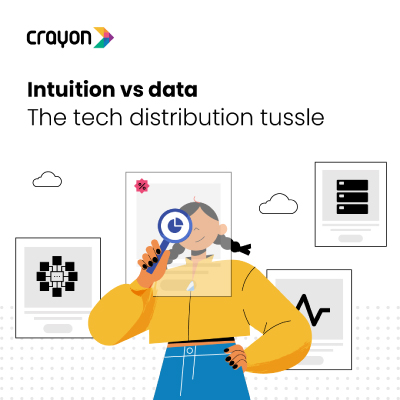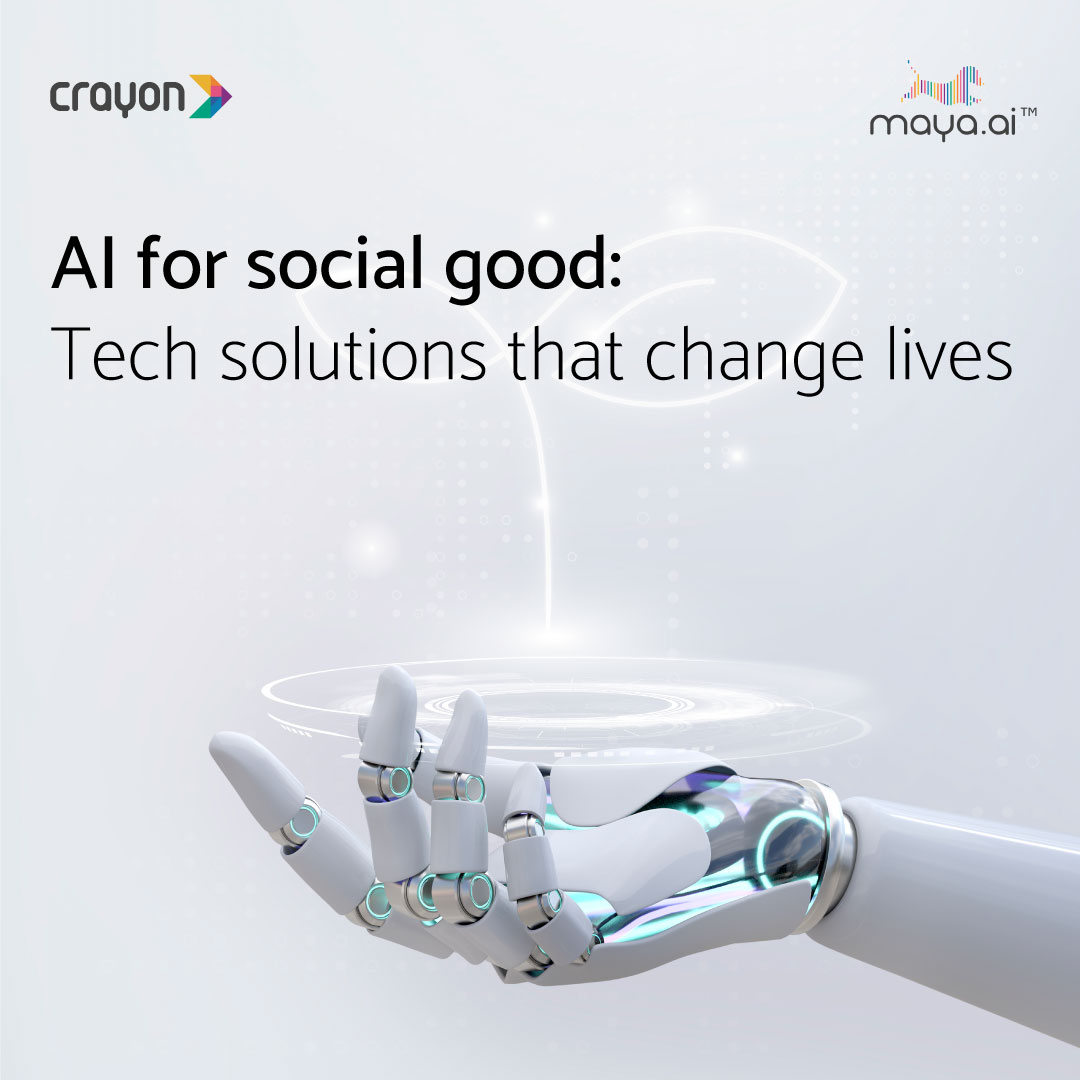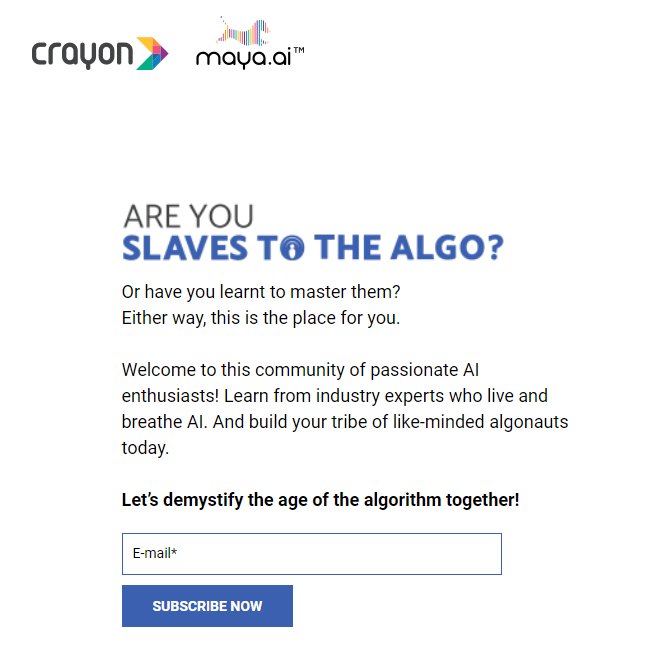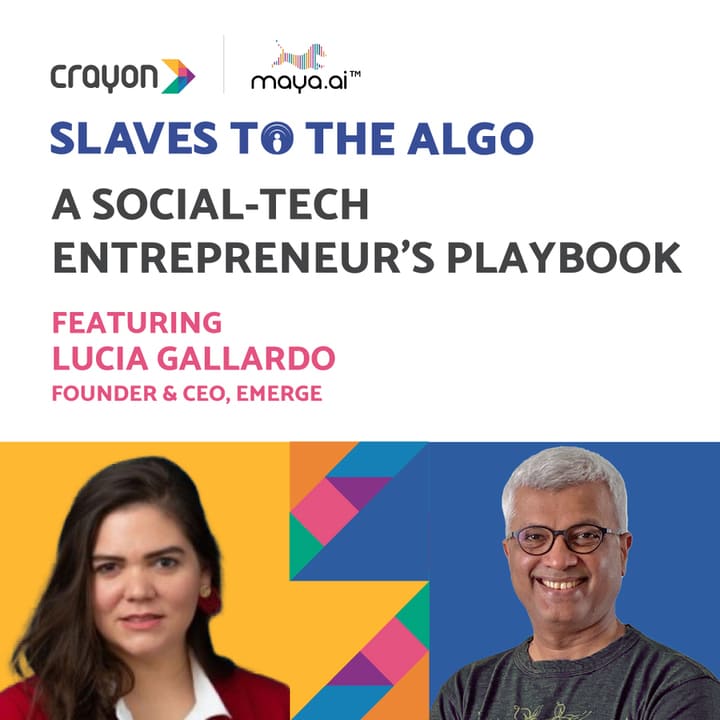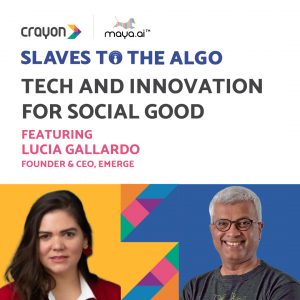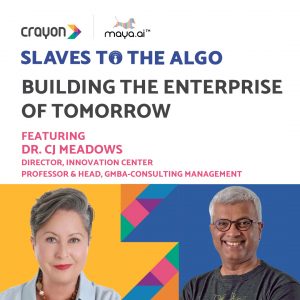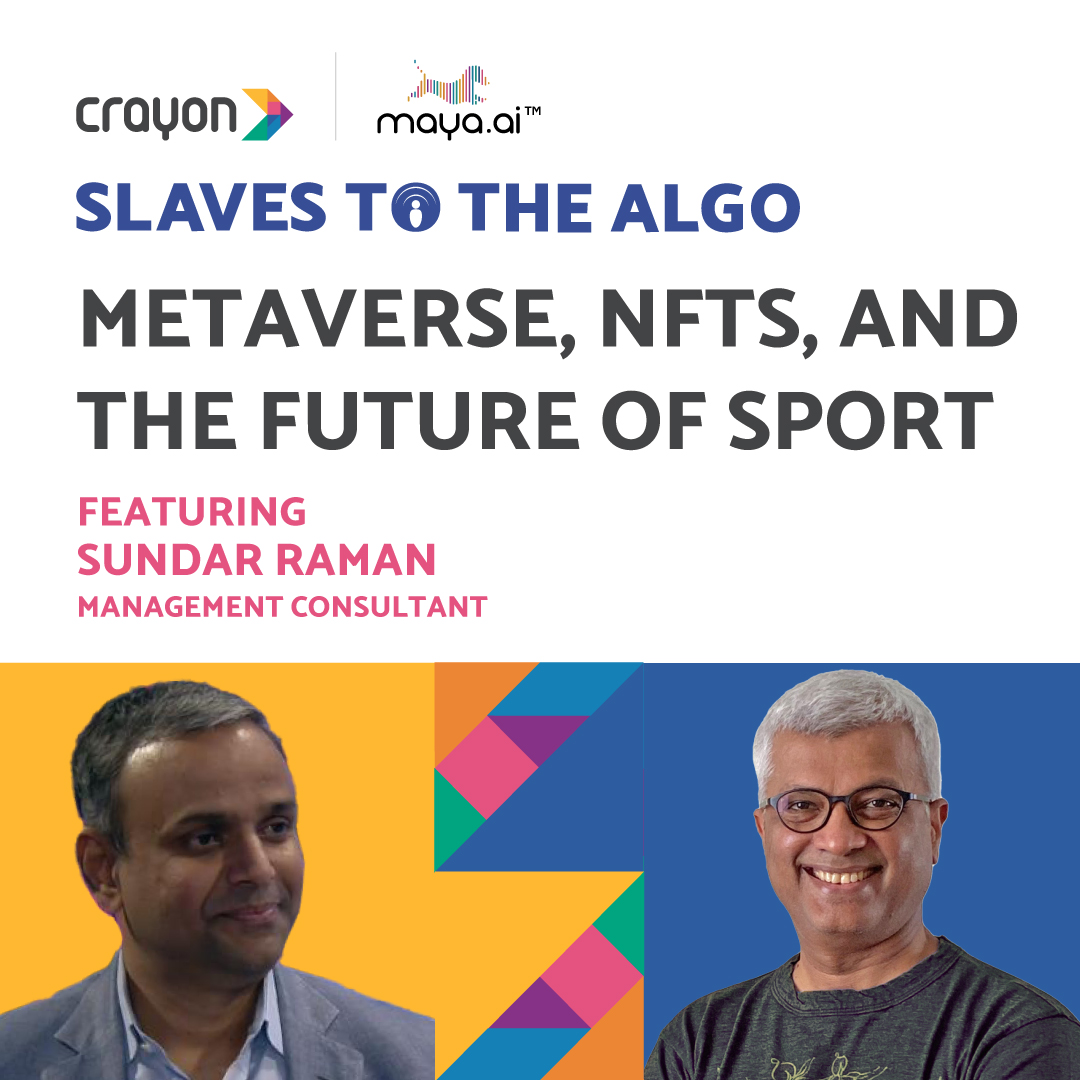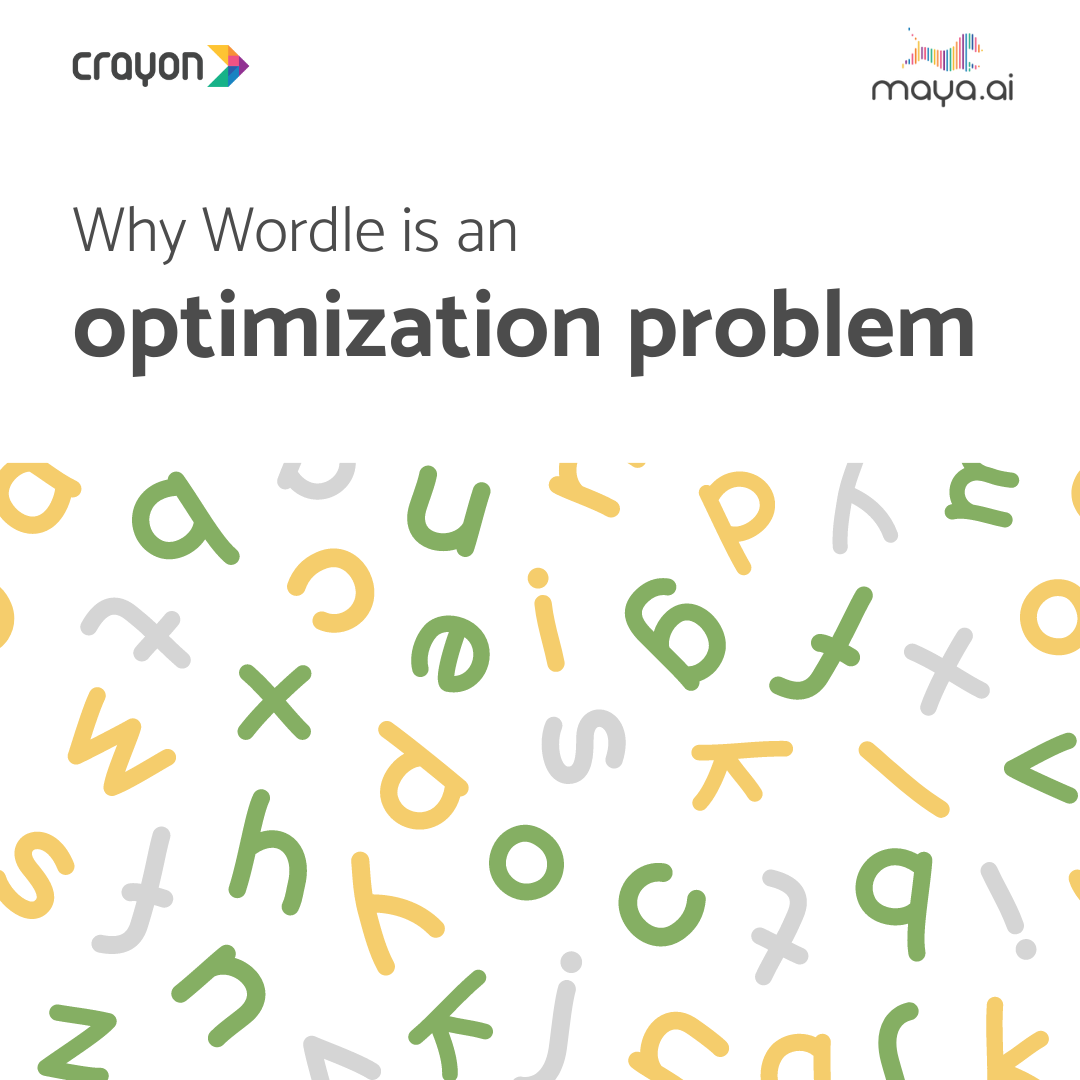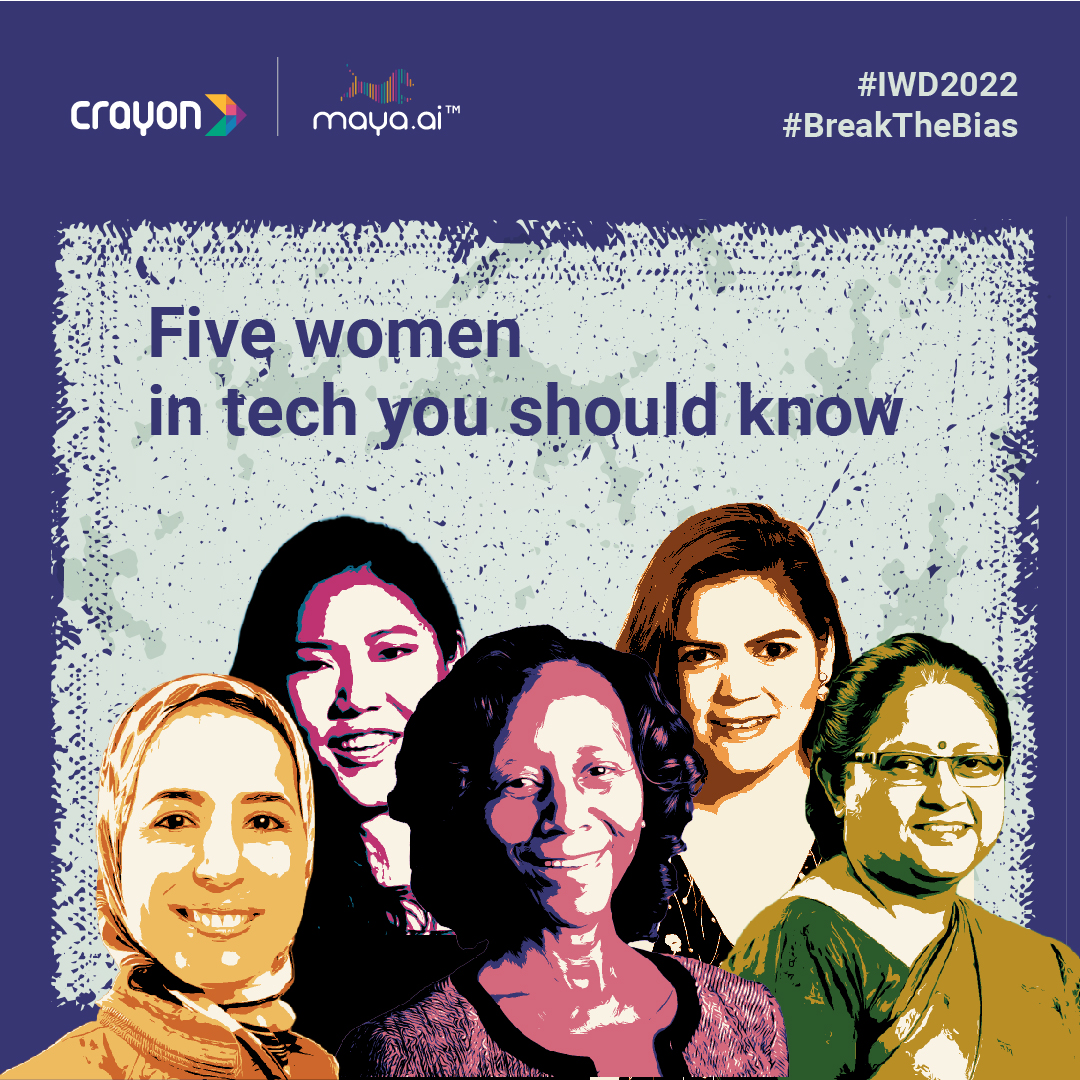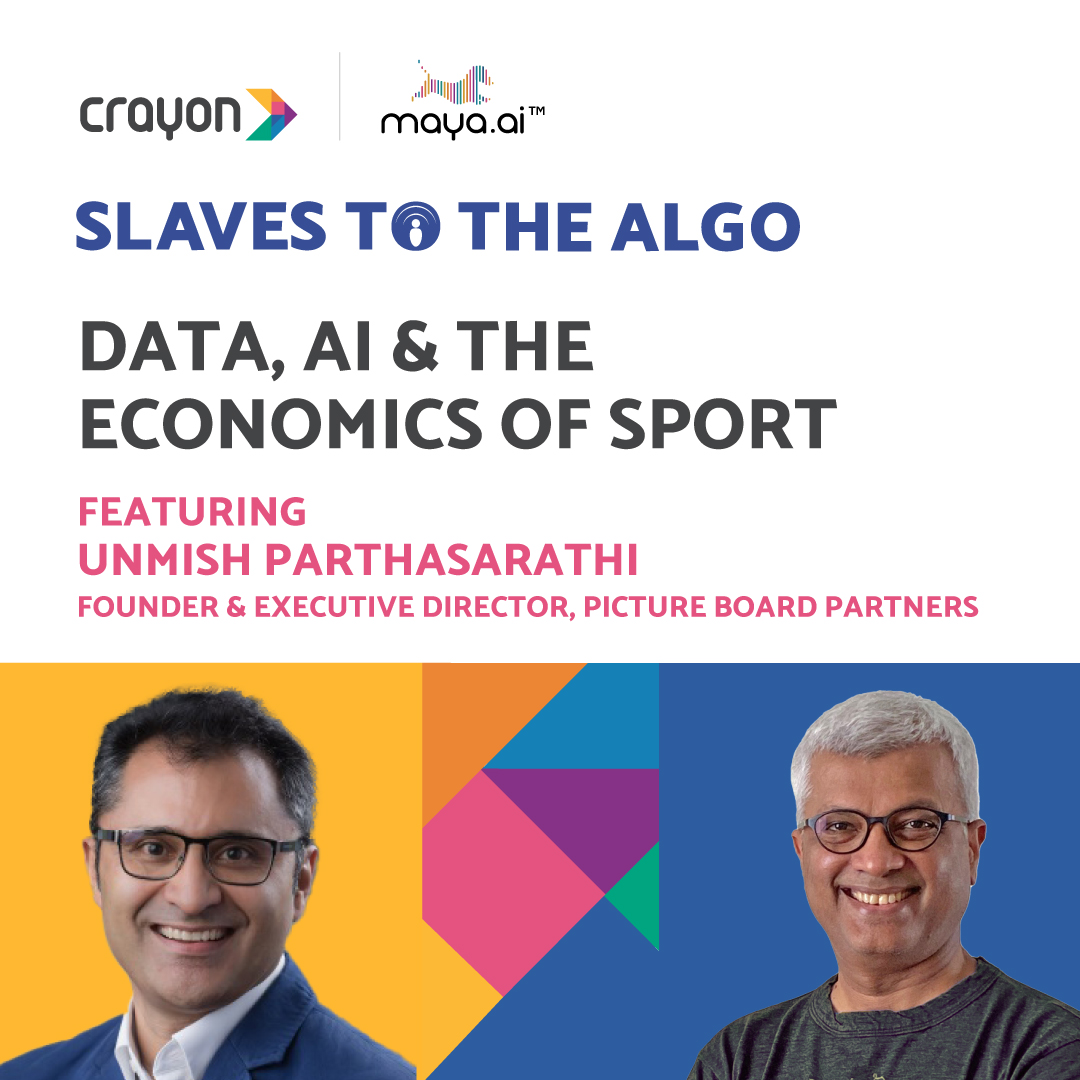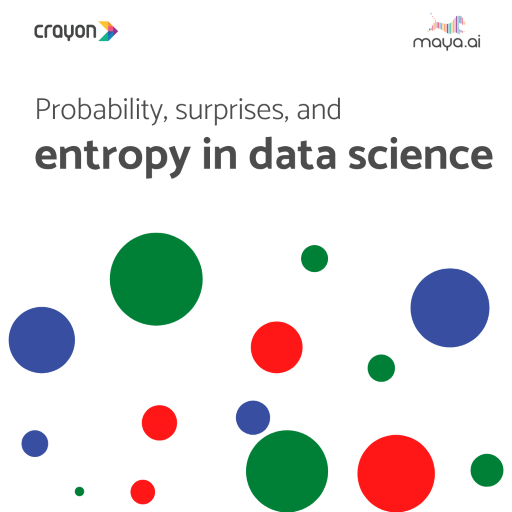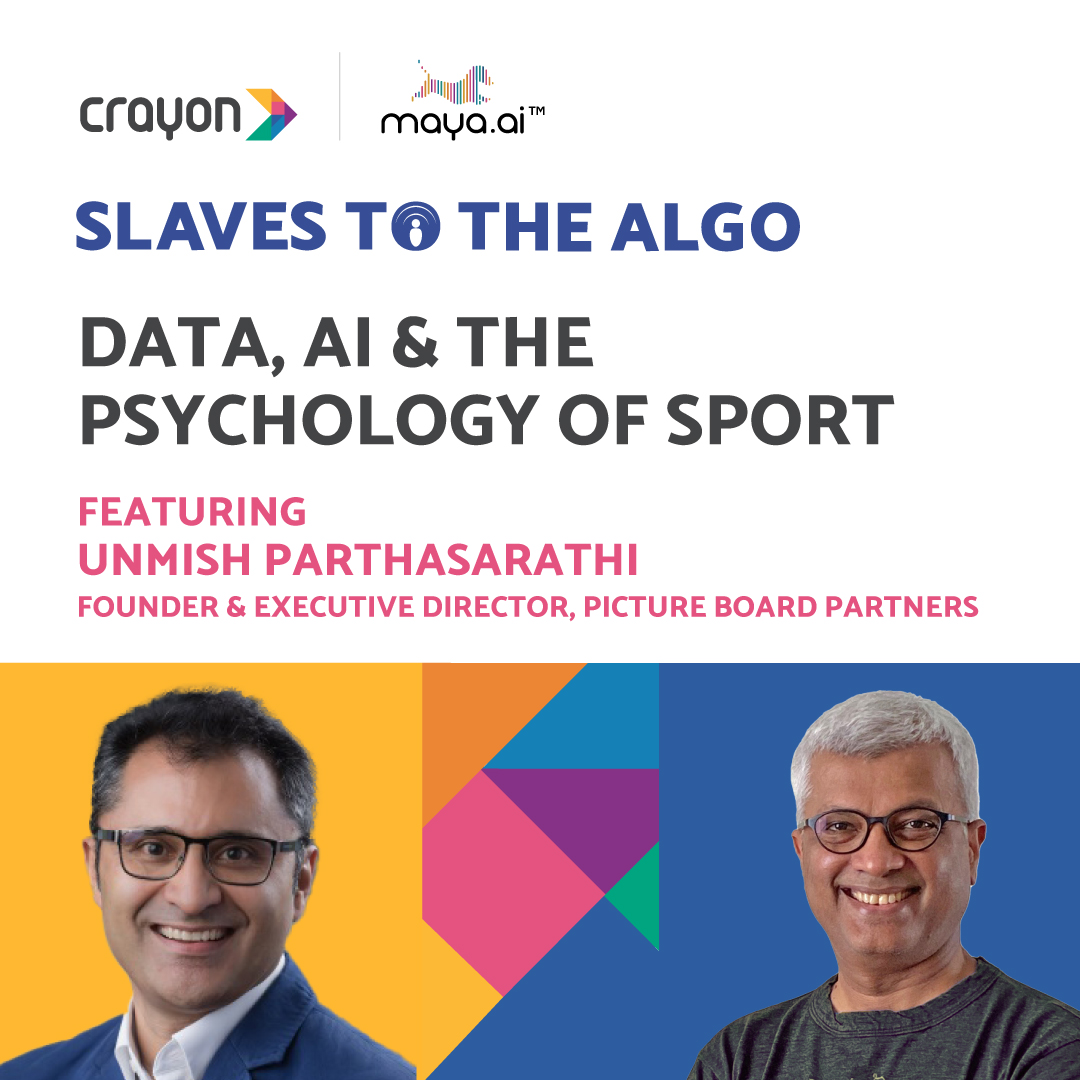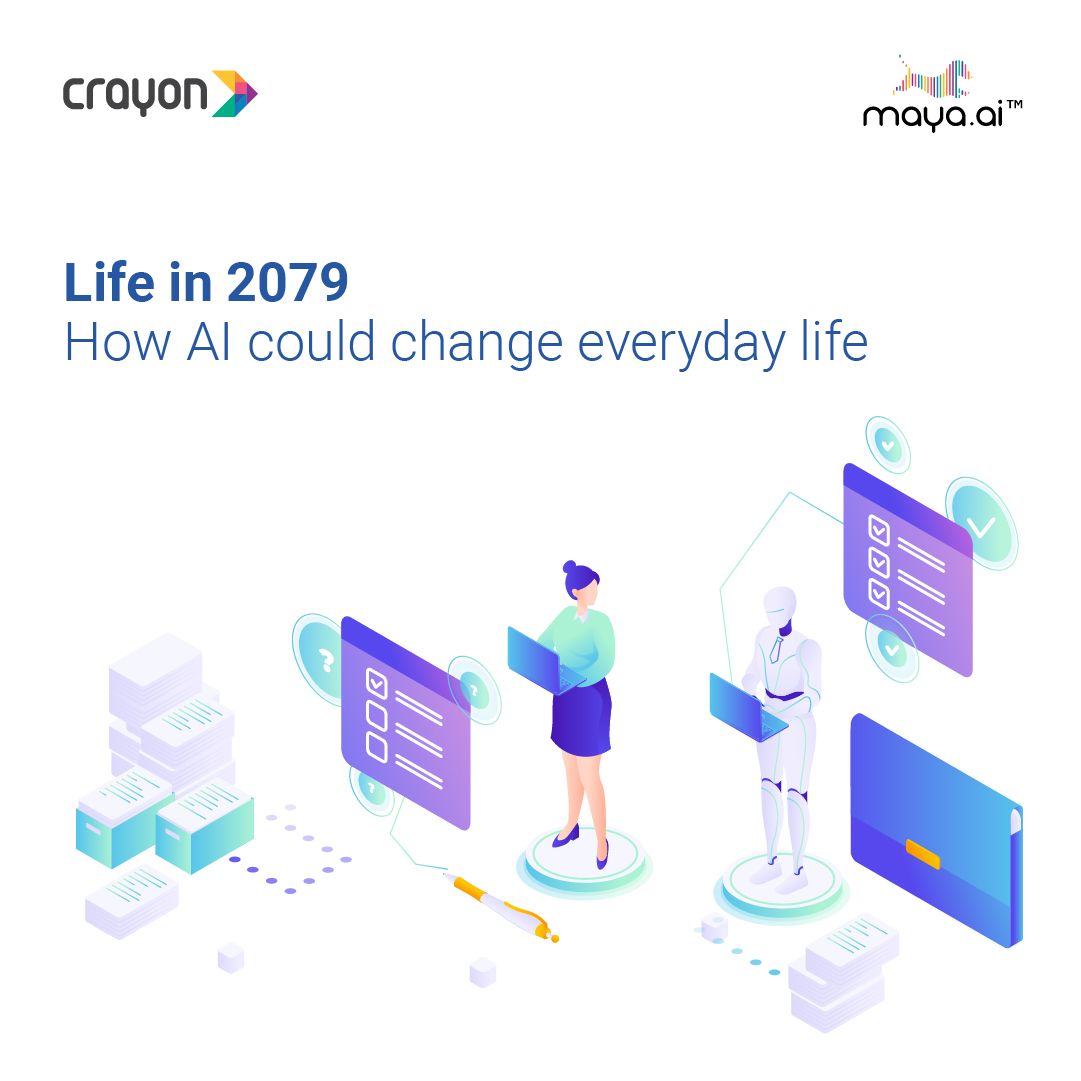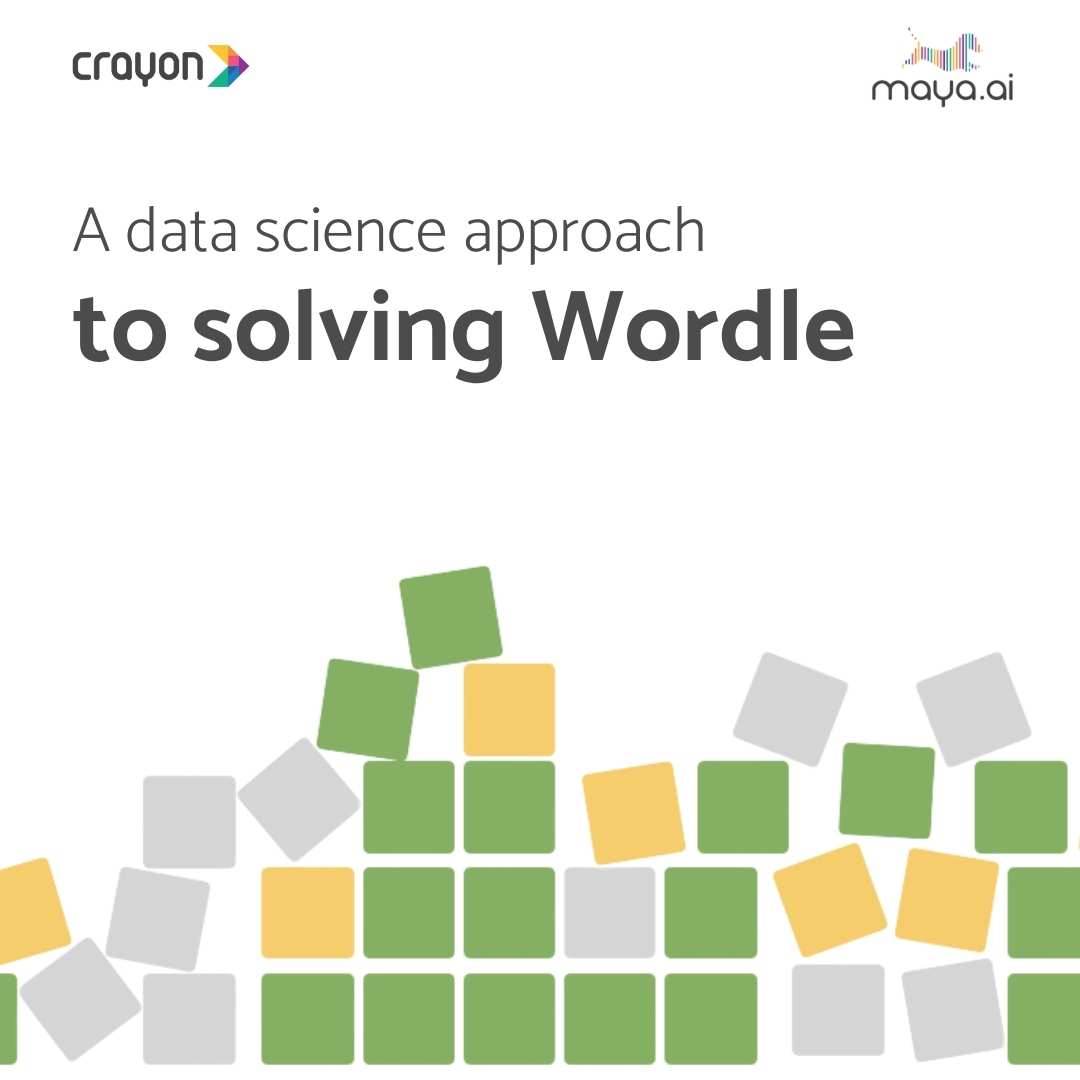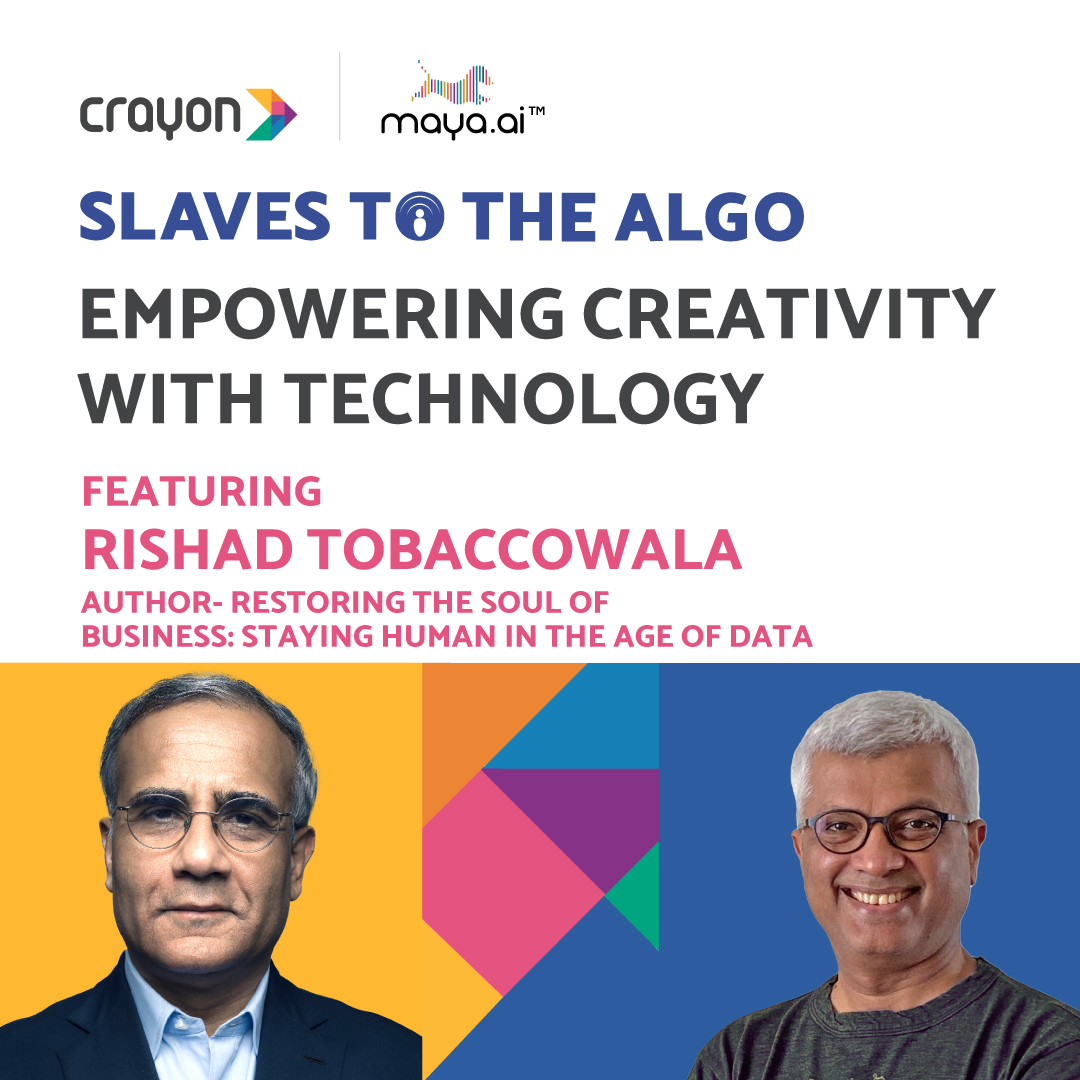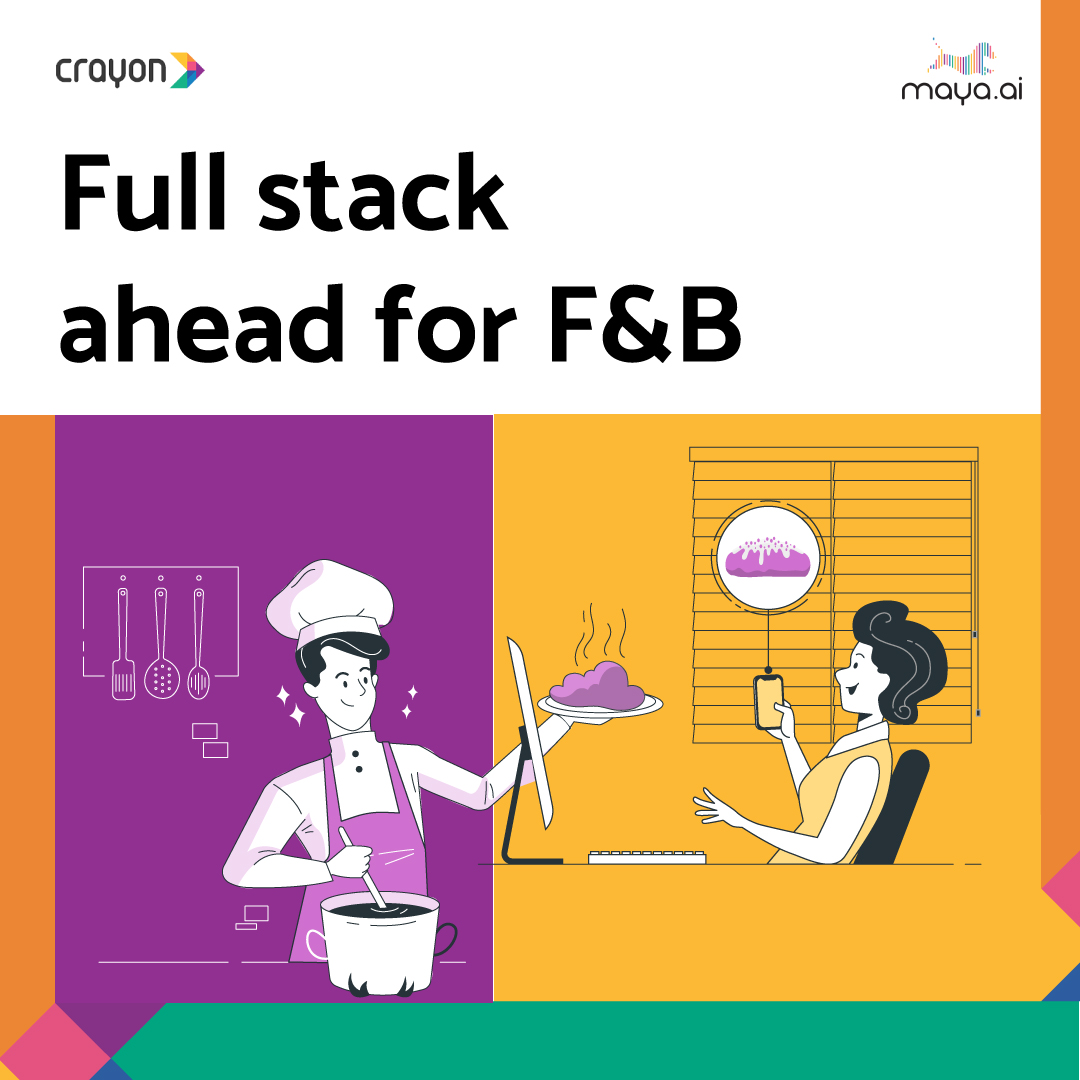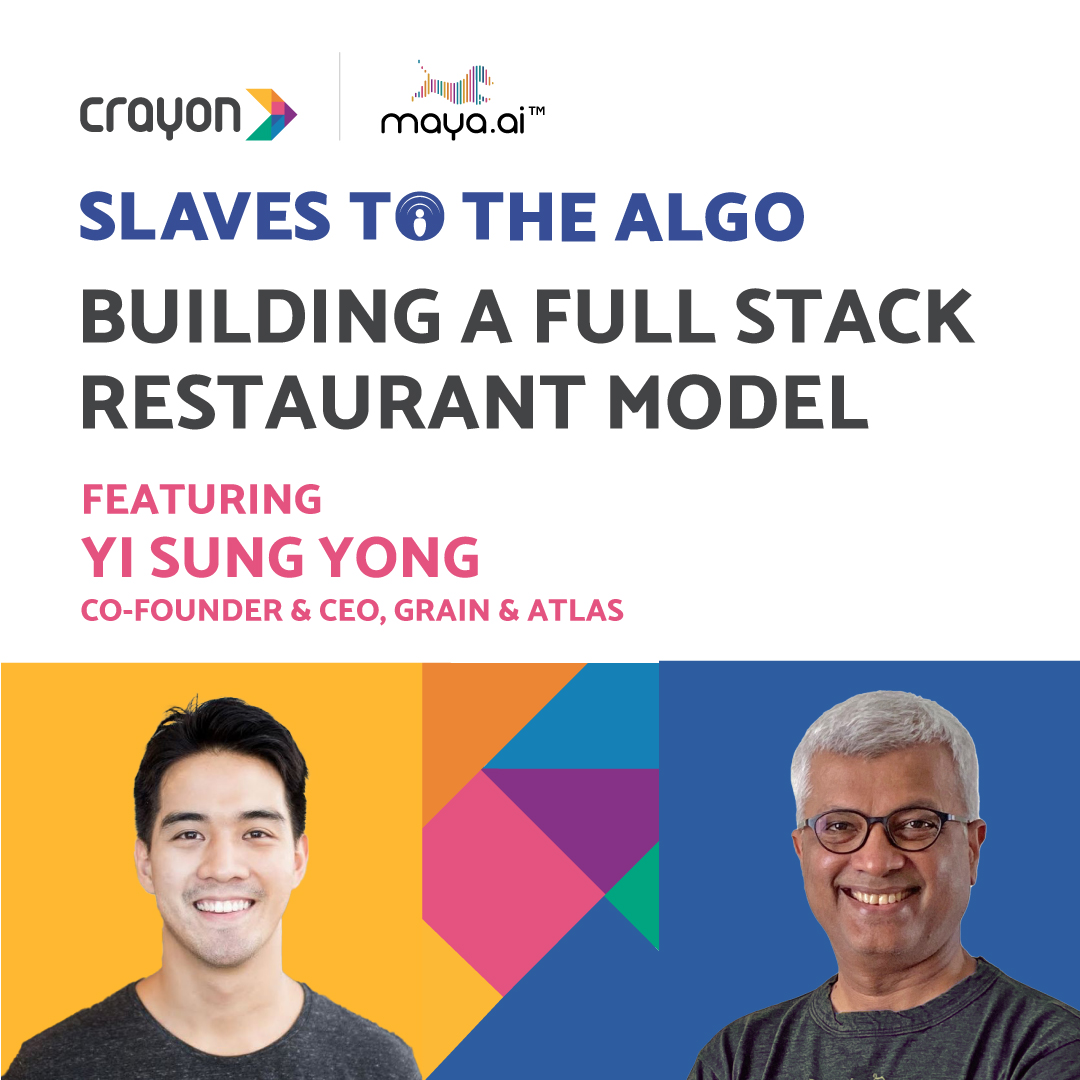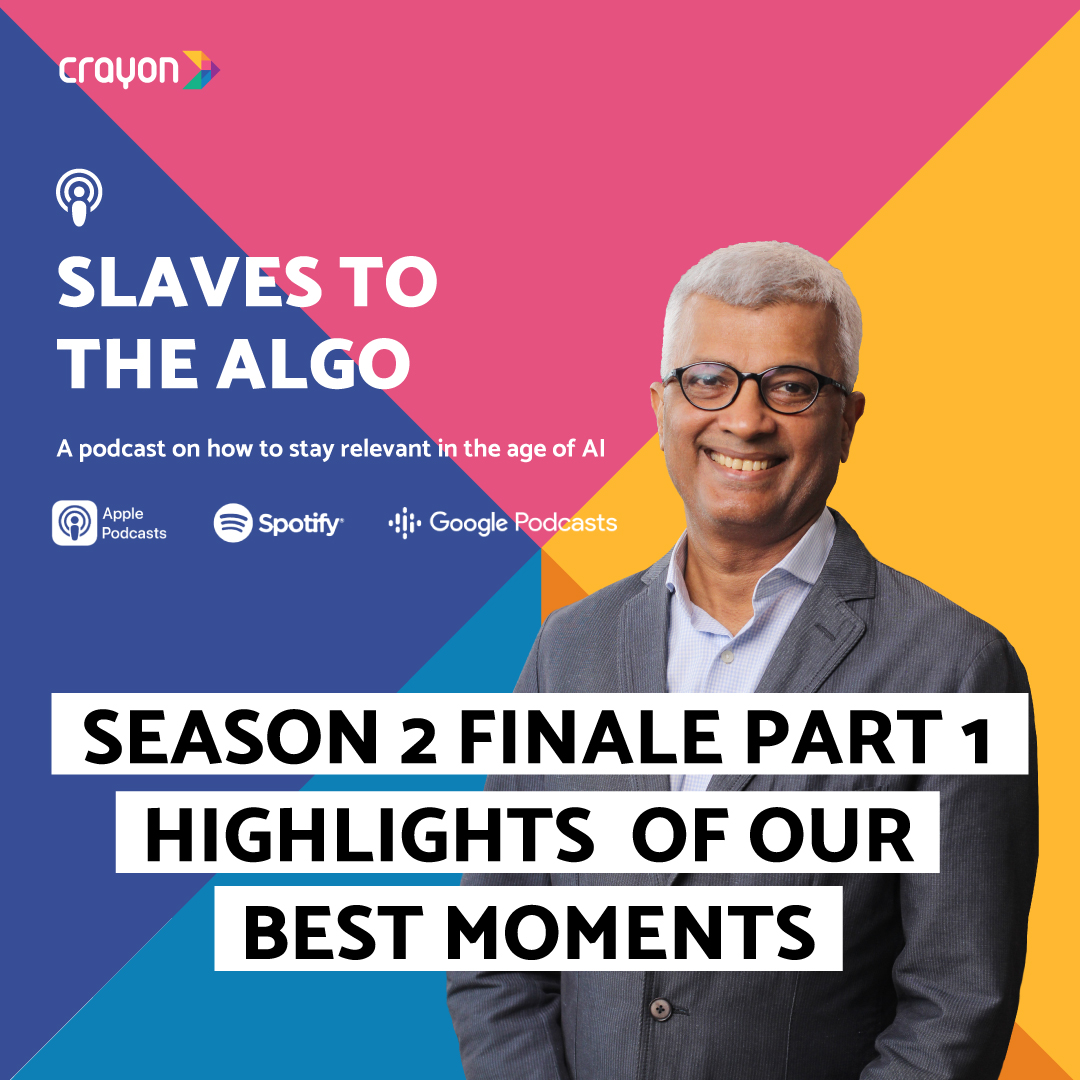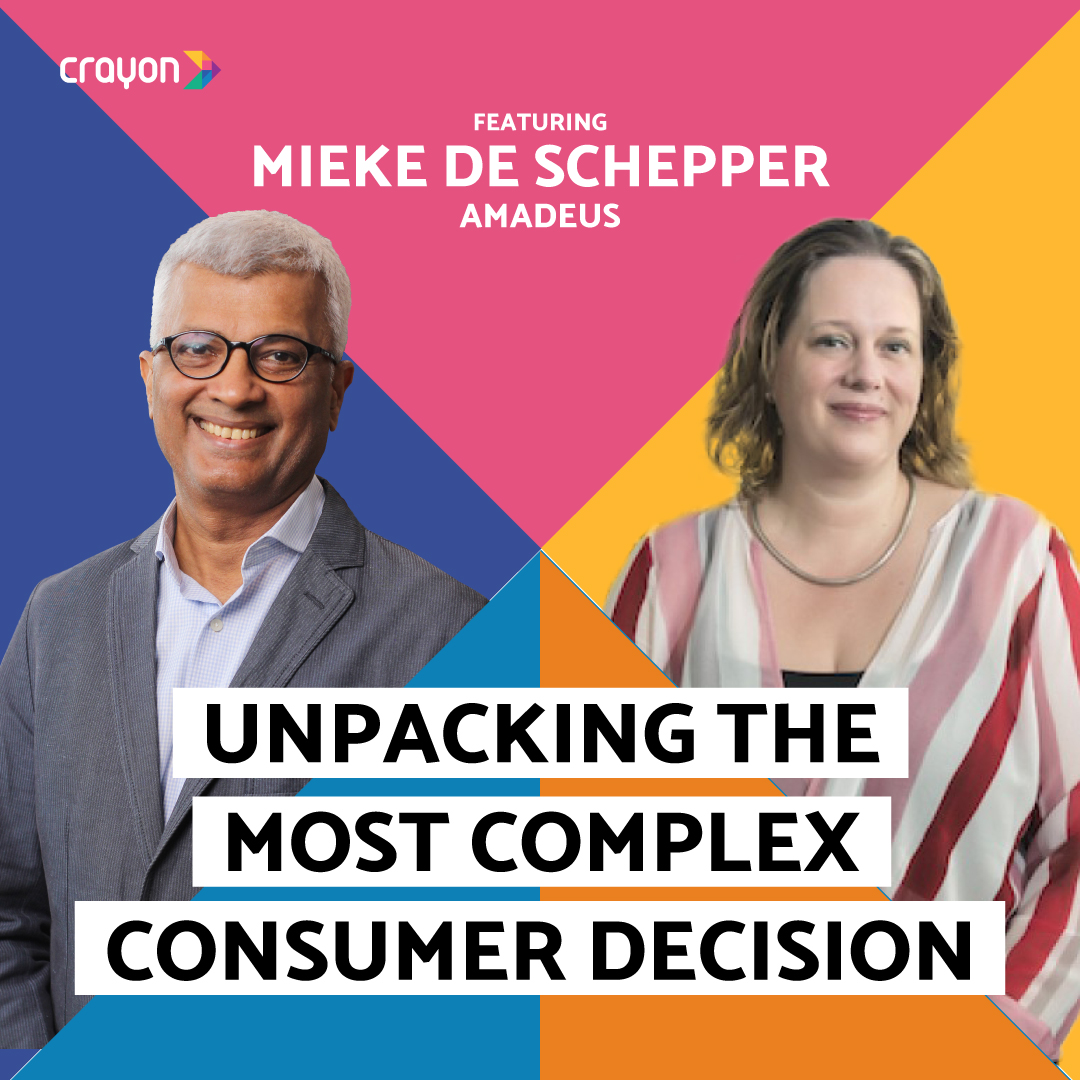Is technology an enabler to sharpen your art? CVL Srinivas believes that it doesn’t matter whether you are in a creative department or PR agency or brand agency. No one can escape technology. Especially since it’s now at the forefront of enabling brands and products to reach out to diverse audiences.
Our most recent guest on Slaves to the Algo says, “As agencies, we sit in a very unique position which is at the confluence of brand, consumer, media, technology. We perhaps have the best seat in the house, when it comes to guiding the client ecosystem in terms of managing the [digital] change.”
In the last 25 years, CVL Srinivas has seen the media industry change – right from witnessing television grow to 800 channels to unleashing the power of data in real time. He has held senior management positions in leading agencies including GroupM (WPP), Madison and Starcom MediaVest in India/Asia-Pacific. Srini has worked closely with several leading advertisers / brands and helped build/scale/transform agency businesses. He now works on helping organizations with their digital transformation journeys – both internal and external.
Tune in to find out how the media industry landscape has transformed over the digital era!
Check out the full conversation between Suresh and Srinivas below.
About Slaves to the Algo
Whether we know it or not, like it or not, our lives have been taken over by algorithms. Join two-time entrepreneur and AI evangelist Suresh Shankar, as he talks to leading experts in various fields to understand how they are using or being used by algorithms in their personal and professional lives. Each episode highlights how businesses can leverage the power of data in their strategy to stay relevant in this new age of AI. Slaves to the Algo is brought to you by Crayon Data, a Singapore-based AI and big-data startup.
Suresh Shankar is the founder and CEO of Crayon Data, a leading AI and big data start-up based in Singapore. Crayon Data’s flagship platform, maya.ai, is the AI platform powering the age of relevance.
How to listen to our podcast
Full transcript of the episode below:
Suresh Shankar
Hello viewers and listeners. Welcome back to another episode of Slaves to the Algo. I’m Suresh Shanker, founder and CEO of Crayon Data an AI and Big Data startup, a podcaster and host of this podcast slaves to the algo. That’s right slaves to the algo. Why because algos are taking over our lives, algorithms and data seem to rule everything. Slaves to the algo is an attempt to demystify this age by sharing my learnings and those of leading professionals in their fields. To understand how they are using and being used by algorithms in their daily and in their business lives. Over the past few episodes and seasons, we witnessed how data and AI has taken over the world of sports of health care, government, education, marketing travel, what continues to amaze me is that even the biggest thing that we do, where we spend our time today, which is the world of media and content, is completely being influenced by developments in data and AI. Not all of that future is dystopian, not all of it is utopian. But I do think that we would all be better served if we understand how data and algorithms are actually running our lives today. The media landscape, right, from content curation, to editing to matching the right content to the consumer to targeting people, is completely being changed by the use of data and AI. And to talk us through some of these changes, and how, in fact, it is the age of the algorithm we have today, a media and advertising wizard with over 25 years of experience. Welcome to the show, Srini. Srini is an ex colleague, he’s had a very distinguished career for well over, you know, close to three decades in media, he pretty much created the media buying revolution with his first job, which is in a small agency, then called fulcrum, which is now I think, the forerunner of the entire media buying industry. And from there, he’s gone on to multiple, bigger, and assignments in various companies like Madison group, the Publicisis group, etc. But now he sits the pinnacle of the Indian media landscape as the chairman of WPP, which is clearly the big daddy of the advertising and media industry, in India and globally. So welcome to the show, Srini. And thank you for being on this podcast.
CVL Srinivas
Thanks for having me Suresh, great to be meeting you, after ages.
Suresh Shankar
And Srini is always senior, I think one of the things that you know, even in our career when we have worked together, you’ve always been both a numbers guy and a creative person, you know, and it’s a very funny thing, because you came up through the media world, where people have traditionally been all about the numbers and like, you know, what the data shows. But you’ve also I think, as a person, being somebody who’s been profoundly creative and innovative in the way you approached it in many of the transformations you’ve driven. But before we go into that, I think I have a personal question for you. Could you give us one example of an algorithm that, you know, that kind of affected you either in your business or you know, as your as a personal life, you know, beyond all these recommendations engine that the Amazons and all that do? And you said, Wow, I didn’t know the data could do that. Any example like that, that you can share?
CVL Srinivas
Yeah, maybe I can talk about, you know, the world of music. And the fact that, you know, I guess most of us are music buffs in some way or the other and all grown up listening to all kinds of music, right. But off late, I also tried to, you know, learn playing the tabla, you know, it’s always been a childhood, kind of a dream, to one day be able to play the Tabla. of what reason I cannot afford as good percussionist I guess. So I actually went and did it the traditional way, I went to school some years back. In fact, interestingly, I quit my job, joined the tabla school, and for one year, I just learned the tabla, I was so so passionate about it. And then of course, I got back into the corporate world. You know, I didn’t really have a regular teacher, but I still did have a few of the gurus coming home every now and then. And then, of course, once I got really back into the thick of things, there was no time right for Tabla or practice of the Gurujis coming home. But thanks to COVID, couple of years ago, it was locked down at home, I kind of rediscovered the passion. And thanks to YouTube to start with, and then a host of other apps, I started learning or rather relearning the tabla. So in fact, nowadays, what I do is, of course, listen to music through various streaming platforms. But every week I try and pick a song or a tune, which by end of the week, in my mind, at least, I need to kind of rehearse and memorize the tabla beads and all the weekend it’s a major project for me, I play the tabla to that particular tune or song and you know, in Tabla there is a system of Taals, there’s a system of beats. So the first thing is to figure out which Taal is a particular tune or song set to and in most cases, that’s about I’ll come to in most cases, you you know, it’s You just figured it out yourself. And then you know, you create that whole piece. And then I mean, I’m not, you know too much to social media at this stage, but I share it with a few close friends every weekend and I get their feedback. One of the things I Wish there was an algo, maybe there isn’t, I haven’t discovered it as yet is if I play a tune or a song, feed it into this machine, it should give me the Taal immediately and say this is the Taal & beyond that also say, by the way, if it’s Keherwa Taal , or Teental or a Dadra call, each of these Taals also have a lot of variation. And you know, different Hindi songs use different variations on the Taal. So
Suresh Shankar
interesting. Yeah, I’m surprised there isn’t an app that does that. Because Shazam does that by telling you the song. Yeah, it’s very easy for every song to know the attributes like the Taal and the beat and the whatever else there is, you can find it out. So maybe there’s an idea out there for some startup guy to go out there and create this.
CVL Srinivas
It’s also a great example of, you know, human beings and AI collaborating , because there are people I follow who actually are kind enough to, you know, tell you what the Taal and raga for particular song are, so you kind of take a little bit from there, and then you kind of try it out. So yeah, so that’s, I guess, something which keeps me going, frankly.
Suresh Shankar
And I’m sure and are you kind of a person in just sticking on that topic of the tabla and the Taal? Are you the kind of person who gets drawn to certain beats and certain Taals? That’s what you keep doing? Or are you? I mean, does the algorithm of the Taal point you towards the filter bubble? Where it’s the same thing? Or does it open a wider world of discovery?
CVL Srinivas
United States race, I think I would ever put it down to the mode, actually, you know, there are there are a couple of taals, which, at least for me are easier than the others. And they’re also more popular, especially amongst Hindi film songs. Keherwa Taal, for example, is probably the most popular. And I know I’m crazy RD Burman, Kishore Kumar fan. So a lot of those songs, for example, are set to this taal. So it depends on the mood. So if it’s, you know, something, which I really want to do and feel nice and happy about and share with a few close friends, I pick a song from there. And some of the taal a little bit more classical and Rupak taal, for example. You know, some of the song from the movie Abhimaan, you may remember the lovely numbers, the set of this taal, is it a little bit more classical. So I reserved those for moments or days or periods where you know, I feel like really need to get into the zone, learn something, you know, feel a bit of accomplished at the end of the day, and try it out.
Suresh Shankar
And, you know, it’s so interesting to talk about it, because it’s such a different take, we all talk about the Spotify playlist and the Netflix recommendation. But in essence, that’s what they’re trying to do, right? I mean, we all know the mood, the mood, the emotion that the music evokes in us. But the emotion is based on certain pretty much scientific things in math and music are very closely related. And that creates the emotion. So in some way, you’re actually saying, what it is that there is an underlying symmetry and a data set and a mathematics to music, which is what drives our emotion. And there’s a lot of interesting work going. But I think there’s somebody out there who’s going to create the thing that can deconstruct that Taal for you. But Srini quickly moving on, I think into the creative world that you are in, you’ve seen a tremendous amount of change in the last 25 odd years. Right? But right from when there were only two things right from an India used to watch the Mahabharata at 10 o’clock and 90% of India, were sitting in front of the television to, you know, the satellite TV revolution to digital the onset of digital and now social, and then that’s taking over. And somehow somewhere the advertising industry has kind of literally been taken over by the Facebook’s and the Googles of the world, right, which account for most of that. It’s something that was coming. It was visible 8- 10 years ago, but most people sat like with an ostrich and didn’t notice it. And you now lead WPP and there’s a whole bunch of transformations that are happening. Could you walk us through how you see that landscape? And what are the transformations of how not just advertising but I think how data and AI are completely changing the way I think brands and agencies are looking at the business, right?
CVL Srinivas
Yeah, all very valid points, Suresh. I mean, being a good media guy at heart and first start some numbers just to put things in perspective. And I’m quoting from the recent group M tyny report, you know, the annual forecasts that he put out on media spend and how each medium is doing etc. Now for the year 2022. That’s just the current calendar year, digital is expected to be the number one medium in India in terms of ad spend. Finally, the day has dawned, Suresh where digital has overtaken TV. So 45% of the total ad spend in India is going to be on digital media in the year 2022 followed by TV, which is a shade less than 40% or 39 odd. So digital TV together is 85%. Now, interestingly, if you look at the global number, Digital Plus TV globally is also 85%. Except that, you know, the interplay between digital and TV is obviously different. Globally, it’s it’s more like 66% digital, and you know little less than 20% on TV. India, it’s still a little bit more even in that sense. So only 15% Going to the other media and the massive growth have actually come in the last few years. And in fact, the last two years post COVID, the numbers or the spends on digital have have really shot up. And I mean, the reasons are obvious, right? I mean, cheaper data prices, people spending more time at home, video taking off in a big way, so on and so forth. So I think the fundamental change in our business is that, you know, earlier, we were, you know, as agencies as organizations, we were, I would say, managers of throughput largely, you know, just managing, let’s say, the flow between the medium and the in the consumer, creating the messaging, doing your planning, and cetera, et cetera, I think today, we have an opportunity to play a far more meaningful role in our clients business, because of all of this disruption and chaos. That is that is happening outside. And today, as long as you know, you make the right investments in data and technology, most importantly, in talent. You know, you can kind of, I would say, thrive in this chaos. Maybe we’ll talk about it a little later in the conversation. But, you know, there are several examples where we’ve been able to kind of move up the value chain, so to speak, you know, given what’s happening around us.
Suresh Shankar
And it’s interesting, you saying, you know, for the first time digital is overtaking television in India, and that’s a big, big moment, and but it’s still 85%. So, you know, are you seeing TV also growing with this thing? Because, you know, the Indian economy is growing? Or is it just like digital is like TV is flat or dropping? And like digital is like kind of every year taking another 10% of market share from the television pie?
CVL Srinivas
Yeah, I would say India is one of the few markets where TV is very resilient, organic business and a medium. And we all know, the big TV properties that even today are massive draws for consumers, for advertisers. And given the just the complexity of the market, the number of languages the you know, socio economic stratification, etc. For some time to come, TVs remain an important medium, which is why how
Suresh Shankar
much of the TV has shifted to this to the watching on a device as opposed to the conventional eye watching a TV set in the living room?
CVL Srinivas
Yeah, so I would say in the recent past, with video taking off in a big way, a lot of the I wouldn’t say a lot of the shift, but I think in certain demographics, definitely a massive shift has happened to viewing it on screens. I mean, it’s not just the younger audience who, for example, watch, even some of the big cricketing tournaments on the small screen. But even people across demographics, who may or may never have had a TV or, you know, straight away going to the mobile phone and watching it for entertainment, news, whatever. So there are these cohorts which are emerging, which are perhaps consuming more of all of this on mobile versus versus television. But if you if you step back and kind of average it out across the whole segment, or the whole population, you know, you know, TV still commands a decent share. So it’s I mean, it’s it’s obviously studies in the last many years that have been done, you know, whether these debates on digital versus TV is, you know, it’s really a combination of the medium and its judicious mix that I guess is needed even today in a brand like India. And I’m sure you notice Suresh very interestingly, if you look at the big spenders on TV, in the last few years, they’ve been the Tech brands. You know, they’ve been the Tech brands they’ve been in fact right now. It’s gaming. It’s FinTech, crypto. Yeah, crypto and all of that, which is spending on TV. And I mean, somebody sitting outside will say, I mean, this is going against the grain, what are these guys doing on such a massive scale? That is
Suresh Shankar
exactly my question to you, and why are these brands on television? If you are on tech, Why you’re not on your Yeah, so
CVL Srinivas
So even today, I mean, if you really want to create an impact in a short span of time, you know, across India, which is what most of these brands companies are trying to do, television is one which can deliver that impact faster. So especially if you’re, I guess in a valuation game, and you want to really make a mark, it’s a medium you kind of can’t do without, of course, you need to have a certain amount of scale and, and budget for that, but I guess most of these players have.
Suresh Shankar
And that brings me to, I think, the role of what I think you know, 25 years ago, you do and I would be doing with, you know, the way the way media is being planned, right? It’s very easy when you had to go and you had 10 things to choose from. But now when you got literally I think a couple of different things that one is digital itself is like, you know, compared to the millions of places on television, you have like, you know, hundreds of channels and spots and so on. And then you have so many other medium coming up. How is the role of the the media person changing in this whole thing from terms of planning and doing that? I mean, what’s the day look like? I mean, we always use data, but we I remember doing it on paper 30 years ago, and then it was a little bit of SuperMidas in a computer algorithm. So what’s the day in the life of that looking? Right? I mean, are they kind of surrendering to the algorithm? And letting that do it and focusing on other things? Or are they actually still shaping the way money is being spent?
CVL Srinivas
So okay, maybe I’ll answer in two parts, maybe I’ll first talk a bit more about the macro, let’s say advertising or marketing services landscape, and how that is got disrupted, or the other way of looking at it is, what are the opportunities, and then I probably drill down a little more into specifically around media etc. Now, again, I mean, looking at looking at numbers, if you look at projections from different sources on the marketing services landscape, in general, which are the different parts that are that are growing, you know, e commerce, if you if you look at it as a area where, you know, we as agencies could play a role. And definitely, we have to get in the way it’s taking off, you know, you know that their projections that it will grow at a CAGR of around 30%. Over the next four to five years, maybe by 2025-26. If you look at marketing technology, or technology, that kind of assignments and consulting, again, you know, projections say that it will grow anywhere between maybe 40, and 50%, in the next four to five years, as a service or as an opportunity. If you look at experience, and all experience management, customer experience, brand experience, all the services that you can kind of bring to the table there, again, you know, very high growth projected over the next four or five years now as against that if you look at the traditional advertising service, which all of us are kind of grown up doing, you know, the CAGRs are in like low single digits for the next four, five years. So very clearly for anyone who wants to be in the agency business today. And if you want to kind of grow your business areas to focus on are commerce, technology consulting, and experience or experience management, these really are the growth drivers, and other ones which contribute a significant portion of your revenue, if you’re still in business in the next five years. While on the other I’m not saying the other side is not important. The advertising, the creative product, media, product, PR and branding, and all of that absolutely important even today, and we just spoke about it. But there it’s all about transformation there. It’s all about how to use technology, AI, ML and everything else to ensure that, you know, you have a service or a product, which is more contemporary. So in a nutshell, one thing he really needs to do is to figure out, you know, how to be a startup and grow in areas like commerce, technology and an experience and on the other side, wear a traditional hat and say, how do I kind of reinvent the old stuff that I’m doing, and the areas we obviously spoke about. So that’s what’s happening at a, I would say, at a macro level as a marketing services industry. But coming down to media specifically, we again spoke about how the media makes us changed globally. And even in India, and even if you look at within the digital advertising pie programmatic advertising is about 35 to 40%. In our estimate, and and again, growing, you know, kind of year after year, and with the kind of, you know, challenges you’re facing on the on the data side, again, maybe we talk about it later, you know, the need for media planners, buyers to be, firstly, a lot more creative with data a lot more knowledgeable, knowledgeable about what kind of data stacks to kind of leverage How do you enrich data stacks? And how do you kind of use that to drive personalization at scale? You know, being a meat being a media person. So gone are the days of these will sound familiar, maybe you have these four, five massive media partners, and you do these, you know, four or five annual deals for the year. And you’re covered, right? I mean, today, it’s like almost on a daily basis, you kind of of course, a lot of it is being done by the algos. But you’re optimizing, re optimizing, pinpointing and working with, you know, host of partners, not just Yes, media partners are there, but data partners, tech partners, content partners, and the ecosystem has got therefore a lot product and your job and goals, you know, creativity and data going hand in hand to kind of
Suresh Shankar
deliver this and that’s the question I have to wanted to absolutely get to because you’ve come to the crux of it. Right? You started off as a media person, now you’re at a WPP media is a big part of it, but obviously the creative agencies that are doing this, right? How are creative people, you know, kind of doing it in this age, when everything seems to be a small snippet or a little widget that’s happening, you know, when you’re telling data shows this. How are creative people, you know, reacting to this whole thing and how is that changing the way in which brands are being built?
CVL Srinivas
Yeah, I guess I guess all folks today understand that, you know, as as agencies we have Firstly, we sit in a very, very unique position that we sit at the confluence of brand, consumer, media, technology, you know, it’s all it’s all happening around us and we pretty much sit at the center. I think what we have going for us, firstly, are the long standing client relationships that we have the fact that we, you know, understand brands and consumers we believe better than, you know, most other partners. And obviously, you know, the creative strengths, etc, that we have. Now, if you look at marketing, again, I’m taking a step back, just to make a point today, if we look at the marketing budgets today and you could you could see this in the Gartner report for 2020 21. You know, in terms of the CMO spend summary, technology today accounts for the maximum chunk of any marketers budget, I mean, this is a global number 26%. And the amount they spend to agencies is actually the lowest number, it’s about 23%. And what’s in between is obviously, the amount they spend on on, you know, their own talent, and so on, and so forth. But technology is already the biggest chunk of the budget. Now, if you see across the board, of course, it started with, you know, categories, like maybe financial services, auto, which were more data savvy, which made the early investments in digital, which, and were also more performance kind of oriented, to kind of start in a way, moving more towards performance driven, creative and performance driven kind of advertising. But now FMCG, players, once digital acquired a certain amount of scale, and once video and vernacular, and everything else started taking off, metrics started falling in place. And slowly they started shedding some of the mental models and have, you know, embraced digital as well. So and of course, in their own way, you know, it brings in a lot of innovation as well, apart from, you know, driving more in a bottom of the funnel kind of metrics. So today, if you’re, whether you’re in the creative department, or a PR company, or a branding company, you can’t escape from the fact that there is technology all around you, which is making it easier for the consumer, first of all, kind of consume your brand, consume your messaging, consume your storytelling, it’s making it easier for the for the brands and products to kind of reach out to kind of diverse audiences. So So I guess it’s how do you kind of use all of these as enablers to kind of sharpen your, your art? And how do you kind of compliment all of the,
Suresh Shankar
the any example of brands that have done this whole fusion of the creativity, the art side and the actual data side? Any things?
CVL Srinivas
lots of examples, but one very recent example, is, of course, the Cadbury’s. It’s not just a Cadbury’s ad campaign, brilliant work done by a will be. And we’ve made both WPP agencies in India collaborating all the way and working with partners, you know, who kind of help kind of stitch all of this kind of together. And here it was, you know, India’s number one, you could say brand ambassador Shah Rukh Khan’s who has kind of video and voice and everything else was was used. And using AI and ML, we were able to kind of get down to creating kind of zillions of avatars of Shah Rukh, which the local trade could then kind of leverage to kind of drive local trade promotion. So it was a it was a brilliant campaign with a lot of purpose kind of embedded in it. Of course, the video is there for all to see on YouTube, the case studies explained. But that’s a great example of how, you know, creativity, data, technology, partnerships, and collaboration at the end of the day, internally and with the decline. And of course, a very, very supportive client was was pushing us to kind of push the envelope all the time, made this made this a great example. And Suki shows
Suresh Shankar
us really I don’t know whether last year not not not this Diwali, but the previous year when you guys ran that ad, I don’t know whether you saw that crayon data spoof on the ad, where we said, you know, if you use really data, you should use that that’s a separate conversation, but you were sorry, going on?
CVL Srinivas
Yeah, I think that’s that’s, that’s an example. And I mean, there are of course, it’s inspired a lot of other such work over the last few months. And also if you look at purely media, and again, the conversation we had earlier right around using data in a creative way to sometimes target demographics that are otherwise very difficult to reach in India. You know, in India, you have this challenge that you could, it’s not just the millennials and so called tech savvy audiences, you could do fun things with but you could equally do a very interesting work to appeal to demographics who are in media dark markets, perhaps only have a feature phone not even though I don’t even know proper smartphone, but have a feature phone, and again, the kind of work that mindshare fulcrum Suresh has done off late for brands like Lifebuoy is just amazing. I mean, what started off, let’s say a few years ago where they created like what they call an adaptive data lighthouse, again, it’s a case study widely published and your viewers could check it out. It also won at Cannes, you know, the adaptive data lighthouse, you know, some years ago was about marrying data from kind of different streams, you know, using modeling, etc, to ensure that these demographics in rural India, you know, get targeted with with messaging with columns on feature phones, talking them about disease, and so on and so forth. And from there to today, in the age of AI and bots and all of that, mindshare fulcrum, again, working with partners has created a video bot, you know, there’s a video about his Well, his voice bot. And you know, feature phones have also got a little fancier today in India, and some of them have the ability to kind of deliver, you know, this kind of innovation. So today there are there are, you know, doctors in the form of video and voice bots, were kind of through feature phones, educating folks who are still in, you know, media, dark areas, you know, about about disease, and so on and so forth. So, yeah,
Suresh Shankar
I mean, I’m really glad to hear that Fulcrum is still kind of trailblazing, I mean, you know, considering all the things that kind of, you know, we were doing in that room, or in that building 25 years ago, it’s really good to hear that. But see, I have a question for you. And I think this is more about, you’re the head of WPP, you’re sitting in there, the landscape is changing, you just said like, you know, fundamentally, everything is going under your feet, digital has already overtaken television, it’s probably going to go to 66. Like the other markets, we have a thing where in the digital space, there are now two large players who are dominating that space. And who are literally taking over , you, how do you see an agency business now competing, where literally, anybody can go there and say, Listen, I can go directly on tour in these platforms, and advertise and so on. What’s the I mean, hasn’t the data and an AI revolution, democratized access to all of these platforms, and advertising in a way where the agency business is kind of disintermediated?
CVL Srinivas
Depends on how you look at it today. I mean, if we had stayed back in time and said that our job is to make advertising our job is to deliver the advertising, I think, a lot of it, I would say all of it. But I think a lot of it today could be done by a platform on its own publisher, or a bunch of startups, right, or smaller companies, and we could be totally out of the business. But given you know, the chaos that’s happening outside what we spoke about the opportunities in commerce, the opportunities and inexperience in, in Mar tech, and so on, and so forth, I think, and the fact that we sit at the center, I think the other way of looking at it is to say that we perhaps have the best seat in the house, when it comes to guiding, you know, the client ecosystem in terms of managing this change. So at WPP, we actually, we call it creative transformation. You know, if you really want to transform your business, or brands or marketing or whatever else, you know, within WPP, we have all the takes to kind of drive a transformation, because we have specialists when it comes to, let’s say, data insights, understanding the consumer and the brand. We’ve obviously got very, very long standing relationships, and very deep understanding of brands and sectors, and so on and so forth, given the portfolio that we kind of manage the creative expertise that we have in house, the media expertise, and you know, all the other elements of the marketing value chain. So as long as you know, we are able to do two things. One is, I think, gone are the days of working in silos, if you’re able to kind of integrate your services as much as possible, and doesn’t mean you kind of dissolve all these companies and make it one amorphous unit because that, again, has its own challenges. But believe me believe we can follow best of both worlds approach where on the one hand, you strengthen your operating companies, but then you build client service or client delivery models, which are a lot more integrated. And that’s what we’ve done in India today. For example, for our top 20 clients, we work in a very, very joined up fashion. And we have a designated WPP client leader for these clients
Suresh Shankar
something more and more like Accenture and IBM because that’s what they do, right. There’s a bunch of different people and practices. And
CVL Srinivas
yeah, that’s the first step. But that’s the first step. That’s the first step. That’s an important first step. That’s an important first step because some years ago, even the creative and media won’t talk to each other. Right and right. And then and then there’s there’s a lot of leakage in that sense. But having done that, having done that, you know the opportunities you have to kind of get into more strategic areas. For example, in a particular case, we have developed the entire data strategy for one of our large FMCG clients. and this was done by putting together a team across different organ, different opcodes of WPP. And we helped the client, not just come up with the data strategy, but you know, actually kind of run it to almost transform their marketing now, and we’ve been doing it for the last year plus, so client building up their first party data stack, we helping kind of enrich that. And then we, you know, building a whole host of use cases. In fact, we started the other way around, first sat down, identified the use cases, so that we, you know, be able to make the judicious investments and set the direction. And, and then, of course, do all the execution that comes downstream, because that’s something which anyway, we are able to do. So yeah, what you said is absolutely right, this, this model helps us go towards, you know, consulting plus execution kind of model, which, again, is very unique, right, you have people either doing one or the other.
Suresh Shankar
And I’m gonna go back to an interesting statistic that I just kind of see, and I’ve personally seen this, you know, in my own transition from being an agency into first saying, you know, into being an advertising guy to saying, data will lead the future, I set up analytics, now I do AI and big data, right. But here’s the interesting thing that, you know, it is the global retail market is 25 trillion ecommerce is 9 trillion. All the advertising, the global advertising work in the world is 700 billion digital is half of that, in a funny way, the whole commerce revolution, where people a consumer can go directly and buy something as literally, and the fact that access and all that stuff has made it possible for every consumer and every seller to talk to each other has almost in a way changed the dynamic of advertising, right? And, you know, if you really look at it, how do you see in this new world where there’ll be almost direct commerce between any consumer any any product that’s going out there, there still needs to be a medium and even we need to still connect the messaging? Don’t you think that the old advertising model is not going to be the, you know, the way of the future when a brand can directly say I have 100 million consumers? I’m going to talk to them directly. On that stuff. What’s your take on this? I mean, you know, it’s an interesting
CVL Srinivas
thing. I think like everything else, models evolve, and need to evolve with time, I think some elements of the so called old approach are still there. I think the most importantly, I think, the power of the idea, or the creative element, I mean, you may talk a lot about data technology, AI, ml, etc. But even today, it’s It’s the power of the idea of the raw creativity, that really moves the needle, right? I mean, that’s, that’s first and foremost, something which we need to kind of recognize and kind of respect. And whatever else we do as an organization, we need to ensure that only gets strengthened. So I think that’s one part. I think the other part is, is relationships. And I think whether it’s the relationships that you build with clients, the relationships with partners, you know, how can they get more meaningful? How can they, you know, ensure that, you know, you’re able to really collaborate at strategic levels, to kind of drive change, and all of that. So I think some of the
Suresh Shankar
relationship between the brand and the consumer itself changing when I can go direct into so many things that I don’t have to use the traditional mass kind of a thing. I mean, it really depends upon the experience I’m offering. You talked about a tabla right. Is there a Shazam like app, which creates an experience in a relationship between me and that?
CVL Srinivas
Yeah. But But Suresh, that, while all of those things are enabled, today, thanks to technology, I think, at the end of the day, if you have to run this systematically, and scale over a period of time, then you need an organization, you need, you know, firstly, some principles and values, which are kind of baked into the whole thing. You need data insights. And it’s not just what the machine churns out, but you know, what people say thick data, in addition to big data, you’ve kind of been through all of that. And then we spoke about creativity and the power of ideas. Yeah. So there is there is, I would say, an even more important role that human beings and by that extension organizations and agencies can play in this day and age of disruption. Yes, it’s changed a lot, for example,
Suresh Shankar
but another thing that you said it very nicely, I think I caught something of that. So yes, but you need to really orchestrate this whole thing. Is that what the new agency is going to look like an orchestrator of all of this, rather than a provider of a service?
CVL Srinivas
Yes, I think in if you look at, again, going back to the areas of growth, right, whether it’s commerce, technology, consulting, whether it’s, you know, the whole experience management services, it’s bringing, yes, a lot of data technology and talent in house, but you know, the, I mean, the issues to contend with, for me would be you know, what is it that you build versus what you buy the classic, build by question. It’ll also be around partnerships, how can you leverage the ecosystem in a more meaningful way to kind of drive that change? And and yeah, I think And then of course, talent, both the combination of upskilling existing talent as well as lateral hires, how do you get people who worked in different industries, people who worked in startups to kind of come into your organization at different levels and help, you know, maybe the change agents? So I think it’s, it’s, it’s a combination of these, which will hopefully, you know, make us more effective in Apple’s But absolutely, I think we have, we have a great opportunity to play that role. And we’ll be seeing it wherever we, you know, got a more integrated model going, we’re seeing strategic value.
Suresh Shankar
controversial question for you! Is WPP, India, which you head, ahead of the WPP family globally, in terms of the changes you’re driving? I’m sure to get you into trouble with your boss, if you whichever way you answer.
CVL Srinivas
Well, I guess, I guess, what are we allowed to say to this question that actually this will get supported is I think we have a good model in India, where we obviously adapted the global vision and strategy very effectively the local market? Because, yes, in any global organization, that obviously needs to be a clear vision and strategy, which is said at the top. But given that different markets operate quite differently, and are at different levels of maturity, etc. You know, it’s, I think, at the local level, it’s all about how do you translate that into into a model that works in market? And yeah, thanks to a fantastic team, great bunch of colleagues, I think we’ve been able to develop a model in India that has worked well for us as a group. And yeah, the five areas of focus range for us as WPP. In India, I think, firstly, it’s all about client centricity. And I spoke about that, right? How do you build more integrated models for clients so that they see the value of the overall group and not just individually? Of course, the second is clearly in the area of tech and data now, how do we leverage, you know, our strengths as a group? How do we leverage partnerships, etc, and bring in a lot more tech and data into our companies? Third, of course, very importantly, people and culture, you know, how do we in fact, we are a market that not only has a Chief People Officer at WPP, but also a chief culture officer, because we believe a lot of these things are cultural in nature, and we need to bring about kind of cultural change. So that’s an area of focus, and then simplifying a structure given that, you know, we we have a matrix kind of an organization, you know, how do you kind of bring in more efficiency at the backend? And, you know, for example, the campus strategy that we have, both in Mumbai and Macau, all WPP offers now sit under one roof. Yeah, and last, but not the least, you know, social impact. And sustainability is another agenda that we drive as WPP in market. So I think it’s a it’s a, it’s a, it’s a good model that has been developed. And as far as they say that there are many more miles to go and a lot more things to be done.
Suresh Shankar
And one last question which is really about from the consumer perspective, but also affects your industry. I think there’s a growing concern among consumers, obviously, about the way that it has been used, privacy is becoming important. Regulators are stepping in. But most importantly, one person simply changed the world by just saying that iOS 14 will not allow you to track devices and will lead to the probably actually, literally the single biggest drop in market capitalization of any company ever witnessed Post that when Facebook announced its results based on Apple’s changes. What’s your take on that? Both from a consumer perspective, which is it good for me, as well as from a business perspective as to what changes as a result that
CVL Srinivas
firstly, you switch any simple role in marketing, which we’ve always followed, anything that’s good for the consumer has to be good for everybody else, the rest of rest of the value chain. So even this particular development, and the phasing out of cookies, and all of that, in all the privacy debates, I think, are extremely good debates. And, you know, we see we positive development, I have my own personal analogy and personal take , if I may be sure, I always felt that was probably the laziest form one of the laziest forms of advertising quite like celebrity advertising. Now that that’s out of the way, I think it’s time to kind of apply, you know, your left and right brain and do a lot of things to kind of drive more strategic value. And let’s talk about three four things that are happening all around us. Firstly, consumers investing time, energy, money effort to build their own first party data stacks, right. And I think wherever we’ve seen that happen, and it’s obviously got fast tracked in the last couple of years, we are actually seeing that activity by itself. It is again, the cultural thing, that activity by itself, transforming that organization, your organization is able to take a step back, look at the business a lot more holistically, look at everything with a data lens and make everything very accountable. And I’m not just talking marketing here. I’m talking supply chain and talking everything else. So that’s, that’s that’s the first positive development that’s that’s come out of this. The second is, you know, again, thanks to AI, utilizing tools, like it’s conversational AI to get more information about the consumer. And we all know the benefit, right? It’s more intent based data that you get, and it’s always going to be a lot richer. The third theme that we’re seeing play out is, you know, brand owners are increasingly getting conscious of what is the value I’m giving back to my consumer, with the data that I’m kind of getting from her is another positive development. And last but not least, you know, you obviously have to move away from individual targeting to an extent and look at cohorts and see what you can do with for now, if you look at each of these developments, race, there are there are positives, right? I mean, this whole thing about, for example, conversationally, it said, is a lot more richer, it’s more intent based data. STG, we already spoke about organizational cultural kind of benefits. And this whole thing about the, you know, value exchange to the consumer just brings in a lot of trust, transparency, openness, especially in this day and age, very, very important. And targeting of cohorts, again, you know, could lead to, you know, more interesting NPD ideas, new product development ideas, which may be difficult if you do if you’re just caught up in individual kind of based targeting. So, I mean, there are, there are, like I said, it’s, it’s an opportunity to kind of reinvent the wheel for an organization, marry left brain, right brain, and, and most importantly, build a lot more trust with the consumer, which, which obviously, is very, very good for business. So it’s that sense of positive development and interesting times ahead.
Suresh Shankar
Absolutely. And, you know, the one of the people who have had on my podcast, ladies and gentlemen called Rishad Tobaccowala, used to be very senior in the Publicis Groupe taught the WPP. But he said something very interesting to me. And I really want to end on this one particular thing. He says algorithms look backward, people look forward. And essentially, I guess he’s saying, when you’re training an algorithm, you’re looking at the data, but the data is always about the past. And it’s trying to make a projection. But people have imagination, which looks forward, sitting as you are in WPP , coming as a media person, I just want you to take on this whole thing of looking back and looking forward the use of data and the use of your imagination. Any closing comments on that?
CVL Srinivas
Yeah, I mean, absolutely. I think it’s not one versus the other. At the end of the day, I think it’s how do you build effective procreation models between human beings and an AI ML? I mean, there are somethings which are absolutely forever. The you know, in the human domain, right, whether it’s compassion, emotions, creativity, raw creativity, strategy, empathy, so on and so forth. And so I mean, even if you look at the, you know, the AI part of marketing or or business transformation, you know, whether it’s in terms of ensuring you have the right kind of data, whether it’s an interest, it’s ensuring you have, you know, algos that are, you know, transparent, that are countable. You know, it’s all it’s all done by human beings, right? So at the end of the day, it’s like, the coder needs an artist to kind of Tango at the end of the day. Otherwise, there’s only that much, you know, the coder will end up being able to achieve.
Suresh Shankar
That’s a lovely way to end the coder meets the artists. And I guess that’s what you’re trying to drive in WPP. I know it’s, you’re sitting at a at the pinnacle of the Indian media and advertising landscape at a very, very interesting time. And there’s so much change, more power to your elbow. Because I think you are in my own working with you. I think you’ve always been able to straddle that media plus creativity. conundrum, if you will. So Srini you know, it’s been an absolute pleasure. I think we could talk for hours more on what’s been happening and what will happen in the industry. But thank you very much for being on the show. It is a pleasure having you to share how I think you’re driving the change and where you see the future going for advertising and media with the use of data. Thank you once again for being on the show.
CVL Srinivas
Thanks. Thanks for having me Suresh. Look forward to catching up in person soon.
Suresh Shankar
Yeah, to my viewers and listeners. Thank you for listening to us today. slave to the algo is available on YouTube, Spotify, Google and Apple podcasts. But we don’t endorse Joe Rogan. We release a new episode every week sometimes more frequently. If you liked this episode, do not forget to like, share and subscribe. And remember to mask up and stay safe in spite of all that COVID is still not fully behind us. Most importantly, stay relevant in the age of AI. Learn to tap the power of the data, but learn also how to harness the power of human emotion as our guest pointed out so well today. See you all next week.
